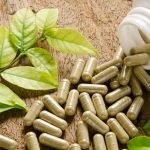Ulcers & Upper: GI Issues Conversations with Seniors
Naturopathic Perspective
Andrew L. Rubman, ND
I graduated from NCNM (now NUNM) in 1982. Taking leave of my senses, I abandoned my plans to open an integrative practice with one of my TCM instructors in Portland, OR, and instead went to New York City after accepting Robert Atkins’ offer to serve as a staff physician in his clinic. Even with a clean vegetarian diet and adequate exercise, after a year and a half of seeing 25 return patients and 10 new patients per day and providing parenteral therapy in an unlicensed state, I was developing stress-related gastritis. I quit Atkins and moved to a practice with a dual-board-licensed MD (psychiatry/oncology) in a funkier section of Manhattan, and wound up discussing my issue with Hans Nieper, a German friend of the doctor. Hans told me to adopt a more stress-free pace in my practice, including treating only the number of patients I felt comfortable with. And, after telling him my age, he quipped, “Young friend, I’m approaching 60 and I guarantee that as you age, you will become more and more interested in geriatrics.” I remember the conversation to this day, and often use my stress reaction and Nieper’s admonition about the many challenges of aging with my older patients.
Aging & the GI Tract
The older patient deserves the same access to information as younger adults, and perhaps can better appreciate the naturopathic physician as counselor and teacher after having endured many decades of myopic, symptom-focused, reductionist advice. With aging, biological systems become more challenged and people become more vulnerable to the adverse effects of the often-histrionic polypharmacy of allopathic medicine. However, this is all the more reason to help folks understand that, just as physiology is taught before pathology, our best defense against dysfunction and disease is the underwriting of normalcy. Heroics have their place, but an attempt to improve upon the wisdom inculcate in what constitutes natural function is a foolish pursuit.
Often, I will start a conversation with seniors by reflecting on the evolution of multicellular organisms. I describe how one of the first pieces of evidence of sophisticated function was the creation of a modified external environment that allowed the organism to more efficiently extract nutrients from sea water, and how this eventually developed into a GI tract. Older patients are often lacking access to information, and yet they frequently require even more support, given the effects of aging and years of “abuse” from lifestyle and allopathic medicine.
Older patients tend toward irregular habits. As a result, discussing diet, including meal content and frequency, is extremely important. Patients should be encouraged to reflect upon the simple fact that without adequate digestion and absorption of nutrients, they are “speeding their journey to the grave.” I often tell them about the famous Victorian NYC physician, Horace Fletcher, aka “The Great Masticator,” adding that chewing 100 times per mouthful was a bit much but that I firmly supported “public mastication” in restaurants! Amusing anecdotes often help them remember admonitions (and may serve to popularize your practice). I tell them that digestion begins in the mouth, both with the autonomic signaling of the upper GI tract via vagal stimulation and the action of salivary amylase on carbohydrates, also that the delivery of this homogenate into the stomach requires peristalsis. And I stress that this is also where the nutritive value of macronutrients such as calcium and magnesium, as well as the release of B12-preserving intrinsic factor, begins.
The patient with gastritis or a history of peptic or duodenal bulb ulcerations will often have an ongoing relationship with a local gastroenterologist. I emphasize my appreciation of their oversight with the barium swallows, endoscopies, and biopsy cytology that help guide our therapy and “keep us out of trouble.” I usually also caution them that though gastroenterologists’ diagnostic acumen and heroics can be highly beneficial, their notions of long-term care are often counterproductive. Many seniors will be cleared for patent ulcers, either gastric or duodenal bulb, or for Barrett’s esophagus, which rarely progresses to adenocarcinoma. They are often instructed to use proton-pump inhibitors (PPIs), H2 blockers, or antacids to treat “hyperacidity,” or “excess stomach acid,” so that the chronically inflamed tissue in the terminal esophagus, stomach, or duodenum doesn’t progress through dysplasia into cancer.
Educating the Senior Patient
In response, I will often pull out my trusty magnum opus on human physiology by Guyton, show them that there is no such thing as hyperacidity, and explain that what the specialist “meant” was “inappropriate” acid production. It is important that we convey to patients that if they are unable to produce sufficient HCl in response to eating, then digestion of almost all nutrients is impaired. Much like crafting a storyboard for a short film, I walk them through the effects of meal anticipation, smelling the food, allowing previously ingested water to pass out of the stomach, and the careful and slow chewing of food on the priming of not only the upper GI tract, but also reflexively on the colon. And yes, it is wise to visit the bathroom and let bowel and/or bladder contents pass before eating, as this supports a “healthy nervous system.” I then describe how the stomach’s insulative/buffering mucus production creates the equivalent of a “glass-lined bottle,” as well as the necessity of an intensely acidic environment, not only for protein degradation via pepsinogen/pepsin production, but also for proper physiological function of one of the body’s most sophisticated valves – the pylorus and the “faux valve” of the diaphragmatic crux comprising the “upper gastric sphincter.”
Armed with this better, albeit partial, functional understanding of some of the physiology of the upper GI tract, we can more easily approach interventions such as dietary modulation and supplementation that can not only control gastroesophageal reflux disease (GERD) and/or what Granny in The Beverly Hillbillies called “the vapors,” but also, importantly, can promote proper digestive efficacy and biliary function. I explain to the patient the notion that an additional function of that mid-meal concentrated HCl “bolus” is to help the stomach maintain a relatively aseptic or “minimally colonized” environment characterized by additional gastric lysozyme and secretory IgA. I point out that the pKa of HCl is an impressive -7, with a pH that is below the point of consistent calculation. Few microorganisms, excepting those with elegant survival mechanisms, like Helicobacter pylori, can survive and replicate in such a hostile environment.
We know that the incidence of hypochlorhydria increases with age. The common consequence of colonization by meal-introduced organisms can lead to focal gastritis, reflux esophagitis, gram-negative bacterial pneumonias, small intestinal bacterial overgrowth (SIBO), and a plethora of colonic disturbances encompassing localized and systemic issues that are well appreciated by our profession. I will often use this lead-in to illustrate the connections between GI imbalances and other diverse and seemingly unrelated problems and afflictions, from autoimmune pathologies to functional disorders. The first steps beyond dietary modulation often involve digestive support coupled with palliative care for possible gastritis – a challenge following gastric emptying. For digestive support, I have found great success using either a “biphasic” digestive enzyme formula (betaine HCl / ox bile, etc) at the start of a major meal or a food-derived multi-faceted formula (eg, Aspergillus– and Saccharomyces-derived enzymes, probiotics, and stomachic and aperient botanicals). The former provides a more aggressive restoration of a strong acidic mid-meal environment as well as robust support for the bursts of chyme ejected through the pylorus into the hopefully slightly alkaline, strongly buffered environment of the duodenum with its biliary and pancreatic contributions.
It is also helpful to support biliary conjugation of metabolites, which often increases drug efficacy and lessens side effects of drugs. To support biliary conjugation, I frequently prescribe a lipophilic fiber like konjac, a biphasic digestive enzyme, multi-B vitamins, and a methyl donor such as N-acetylcysteine. Patients report feeling better on their pharmaceutical regimes, and their primary-care physicians are frequently able to reduce the dose of their hypertension medications. In many cases, they have completely withdrawn their statins.
For the patient with a history significant for a healed peptic or duodenal bulb ulcer, it may be good to consider the addition of a systemic enzyme formula. I had followed the development of a concentrated nattokinase (derived from the fermentation of soy by Bacillus subtilis), which acts as a fibrinolytic in the body, acting by directly hydrolyzing fibrin and 1 or more plasmin substrates. Studied very thoroughly in Asia, nattokinase is now in a Phase II study at the National Science Foundation. When combined with serrapeptase (seratiopeptidase), which acts as a systemic proteolytic, I have found it to be clinically useful in a number of applications, including normalization of injury subsequent to gastric ulceration. As with all fibrinolytic formulae, the dose should be well timed to be introduced after the environment is stabilized, increased incrementally, and optimally introduced 1.5 to 2 hours post-prandially. The mechanism involved in the monocyte/macrophagic fibrin degradation is still being elucidated and is beyond the scope of this commentary.
Summary
The aging patient is increasingly vulnerable to irregular bowel habits and GI imbalances such as hypochlorhydria, which in turn can contribute to malnutrition, focal gastritis, GERD, SIBO, and a variety of systemic disorders. Conventional treatment of peptic discomfort with PPIs, H2 blockers, or antacids only exacerbates these problems. Educating the patient about the workings of the entire digestive system is key in fostering dietary and lifestyle changes. A clinical review of dietary intake, eating habits, digestive, and other concurrent complaints, coupled with well-timed supportive supplementation and transient palliation can not only provide long-term relief for the elderly gastritis sufferer, but also remedy other issues, from drug tolerance to gastric scarring.
 Andrew L. Rubman, ND, is a naturopathic physician in his 36th year of clinical practice. Dr Rubman provides primary care and distance consultation worldwide, with special interests in gastroenterology and reproductive endocrinology. Active in national media, governmental and corporate affairs, and on multiple boards, Dr Rubman is a founder of the American Association of Naturopathic Physicians, secretary of the Endocrinological Association of Naturopathic Physicians, and professional member of the Gastroenterological Association of Naturopathic Physicians. He is also an alumnus of the National Ski Patrol, a General Class Amateur Radio licensee, and a PADI Divemaster. Website: http://www.naturopath.org
Andrew L. Rubman, ND, is a naturopathic physician in his 36th year of clinical practice. Dr Rubman provides primary care and distance consultation worldwide, with special interests in gastroenterology and reproductive endocrinology. Active in national media, governmental and corporate affairs, and on multiple boards, Dr Rubman is a founder of the American Association of Naturopathic Physicians, secretary of the Endocrinological Association of Naturopathic Physicians, and professional member of the Gastroenterological Association of Naturopathic Physicians. He is also an alumnus of the National Ski Patrol, a General Class Amateur Radio licensee, and a PADI Divemaster. Website: http://www.naturopath.org










